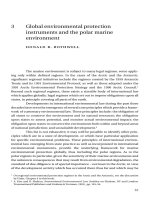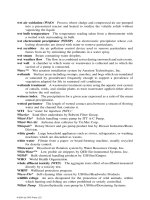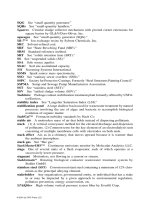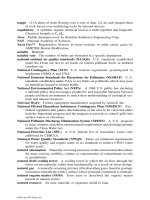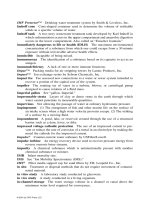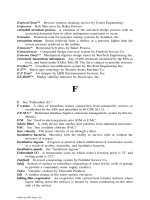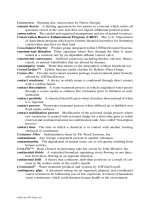Fact sheet: environmental tax reform and competitiveness
Bạn đang xem bản rút gọn của tài liệu. Xem và tải ngay bản đầy đủ của tài liệu tại đây (242.86 KB, 4 trang )
Low Carbon Green Growth Roadmap for Asia and the Pacific
FACT SHEET
Environmental tax reform and competitiveness
Key points
•
Environmental tax and fiscal reforms can have an overall positive effect on competitiveness
•
ETR stimulates investments in resource efficiency, while EFR off-sets additional costs with targeted
incentives
•
At the level of individual enterprises, fist movers will enjoy a competitive advantage, while the
potential negative effect on some energy-intensive sectors can be mitigated
Competitiveness explained
Competitiveness is a measure of a country's advantage or disadvantage in selling its products in international
markets.1
How it works
A country (or a firm) is competitive if the cost of production and commercializing, including labour and expense
of materials, marketing and other overhead expenses, generate products and services of a quality and price on
par with similar products and services in the market place.
Environmental tax and fiscal reforms change market prices of different inputs to production, such as energy,
natural resources and labour.
The revenue collected from environmental taxes can be successfully directed into investments in measures that
will boost the competitiveness of domestic producers, including resource efficiency improvements of small and
medium enterprises.
Concerns related to environmental tax and fiscal reforms
Critics of the environment tax and fiscal reforms (ETR and EFR) have made claims that environmental taxes
adversely impact the competitiveness of the levying countries and cause resource-intensive industries or firms to
flee to other countries with less strict environmental protection policies. Within the literature this is often referred
to as the pollution haven hypothesis.2 Although a pattern of industries relocating from industrialized to developing countries does exist, it appears that the prevailing opinion within the pollution haven hypothesis literature is
that environmental regulation is a small, almost inconsequential variable. More significant factors as to the
reason for relocation might be the emergence of new or faster growing markets, lower corporate income taxes
or cheaper labour. Box 1 provides a summary of a recent European Union study on the impact of environmental
taxes on competitiveness, which concluded that, overall, the impact of such tax reform is largely beneficial to
industries and the economy.
1
2
OECD glossary of statistical terms, available from (accessed 15 March 2012).
The pollution haven hypothesis argues that environmental taxes adversely impact the competitiveness of the levying countries and
cause resource-intensive industries or firms to flee to other countries with less strict environmental protection policies.
Low Carbon Green Growth Roadmap for Asia and the Pacific : Fact Sheet - Environmental tax reform and competitiveness
BOX 1: Impact of environmental tax reform on competitiveness in Europe
The purpose of imposing carbon and energy taxes has generally been to reduce carbon emissions and energy
consumption while not compromising economic growth. This concept of detaching economic growth from
energy consumption and carbon emission growth is often referred to in the literature as “decoupling”. Studies
indicate that European Union member countries that have used market-based instruments, such as carbon and
energy taxes, are more energy efficient and competitive than the European Union on average.
According to the Competitiveness Effects of Environmental Tax Reforms (COMETR) project, six European countries (Germany, United Kingdom, Finland, Denmark, Netherlands, and Sweden) that adopted environmental tax
reform (ETR) experienced reductions in demand for fuel (an average of 2.6 per cent in 2004) with no negative
impact on economic growth regarding GDP. Largely as a result of the ETR by 2004, emissions in the six countries
had decreased by an average of 3.1 per cent and a remarkable 5.9 per cent in Finland. Carbon and energy
taxes did cause an increase in the consumer price index – which was expected – and certain energy-intensive
industries were slightly affected. However, due to revenue recycling and exemptions, the negative impacts were
minimal.
Source: Competitiveness Effects of Environmental Tax Reforms Project website: www2.dmu.dk/COMETR/ (accessed 15 March 2012).
Alterations in policy that place some companies in a better competitive position will undoubtedly put others in
a worse position. It is thus beyond question that under the application of ETR and EFR, both “losers” and “winners”
will arise. The winners, however, will be the businesses that can adapt by improving their eco-efficiency through
new innovative solutions and ideas and, at the end of the day, increase their competiveness within both domestic and international markets.
Such tax and fiscal reforms can drive long-term innovation and resource productivity improvements, which will
help businesses hedge their risks in an extremely volatile commodities market and countries reduce their
dependence of foreign resources, such as fossil fuels.
While theoretically policymakers should be more concerned with long-term national competitiveness, more
often in reality greater attention has been directed to the short-term consequences affecting certain losing
sectors and, sometimes, even specific businesses. This has probably been due to the political ramifications that
may arise from the expressed discontent of “losers”, which tend to voice their perspective in public arenas more
actively than winners.
Measures to address competitiveness concerns in introducing ETR
Various measures can be adopted to not only appease losing firms and sectors but also to ensure their ability to
adequately adapt to new policy measures and maintain international competitiveness. These may include the
following:
•
3
Introduce special arrangements for energy-intensive industries. While most industries and firms are not
likely to be significantly affected by competitiveness impacts, there may potentially be more
pronounced impacts for sectors that simultaneously exhibit a high energy-intensity, high trade-intensity,
a high share of costs as energy expenditures and a low ability to pass costs on to consumers.3 In cases of
highly energy intensive industries, the use of energy is essential to the processes and therefore makes
up a large portion of operating costs. This may include sectors such as aluminium, steel, cement, paper,
glass, etc. In these situations, special arrangements such as tax rebates, sectoral exemptions, voluntary
agreements, targeted subsidies for R&D, green job training and transition assistance, have been used in
many European countries with ETR. These special arrangements can address competitiveness concerns
and increase the political feasibility of ETR.
Paul Ekins and Stefan Speck, GFC Briefing Paper 7: Competitiveness and Environmental Tax Reform (London, Green Fiscal Commission,
2010).
Low Carbon Green Growth Roadmap for Asia and the Pacific : Fact Sheet - Environmental tax reform and competitiveness
Box 2: The United Kingdom’s Climate Change Levy
In order to address competitiveness concerns of the Climate Change Levy (an energy tax targeting business
and commercial users), the UK government introduced Climate Change Agreements, a concessionary tax
reduction scheme allowing individual industrial sectors to flexibly negotiate with the government over sector
specific targets of energy efficiency improvement or GHG reduction in conjunction with the Agreement. As a
result, eligible energy-intensive industries can obtain up to 65 per cent discount from the climate change levy,
on condition that they meet agreed targets in energy-efficiency improvements or carbon emissions reductions.
•
Utilize part of the revenues in a way that can offset increased energy costs for enterprises. Reducing
corporate taxes can provide incentives for capital accumulation and encourage more investment and
business activities. This, in turn, may partly or entirely offset increased energy costs especially for those
firms with a low level of energy- or resource-intensity. In Europe, this revenue recycling has played a
critical role in compensating for the higher energy prices and bringing about a positive GDP gain of up
to 0.5 percent.4 Tax reductions can have different impacts on different firms, depending on their energy
and labour intensity and the tax/fiscal structure.5 For example, labour tax cuts may benefit labourintensive producers. Reducing labour taxes or social security contributions may also address competitiveness concerns. This has been the case of some European countries with introduction of ETR: Denmark,
Germany and the UK reduced employers’ social security contributions while Finland and Sweden
reduced labour taxes as a part of their ETR. In Germany, reducing employers’ social security contributions
substantially decreased the energy tax burden on both chemicals and basic metals.6
•
Gradually phase-in the reforms. Gradually increasing tax rates over a set time period can ease the initial
burden of compliance and provide financial flexibility to retool the production capacities. Relevant
policy options include providing lead-in times, announcing the level and implementation date in
advance and enacting a relevant law.
•
Ensure predictability and consistency of reforms. Credible, clear and concrete future policy directions
and goals within a firm legal and regulatory framework enables businesses to make long-term strategic
and investment decisions.
•
Involve affected industries and other stakeholders in the design stage. Widely consulting and involving
industries and other stakeholders will make them not only effective partners but also genuine supporters
for the reform measures. The stability and consistency of the ETR policies are shown to be positively
related to firms’ willingness to invest in low-carbon technology.
Concerns about business relocation and carbon leakage
Competitiveness issues can also translate into environmental concerns: if firms relocate to other countries with
less stringent environmental policies, net carbon reductions may remain neutral or even increase. While studies
provide a high range of variation in leakage rates, experiences indicate that business relocation and consequent carbon leakage may be unlikely to be substantial in practice, if ETR is properly designed and implemented
with other complementary measures.7 It may be partly due to the fact that business location has been driven
by local market size and demand, transportation costs, wage levels and product variety rather than
carbon/energy taxes and the cost effects of ETR tend to be small.8
4
Ibid.
5
Ibid.
6
Ibid.
7
Terry Barker and others, “Carbon leakage from unilateral environmental tax reforms in Europe, 1995-2005”, Mikael Skou and Paul Ekins,
eds., Carbon Energy Taxation: Lessons from Europe (Oxford, Oxford University Press, 2009).
8
National Environmental Research Institute, Cambridge Econometrics, the Economic and Social Research Institute, Institute for Economic
and Ecological Policy and the Vienna Institute for International Economic Studies, Competitiveness Effects of Environmental Tax Reform
(COMETR), Publishable Final Report to the European Commission, DG Research and DG Taxation and Customs Union (Roskilde, Denmark,
2007).
Low Carbon Green Growth Roadmap for Asia and the Pacific : Fact Sheet - Environmental tax reform and competitiveness
Border tax adjustments (BTAs) can, in theory, create a level competing field for competition between domestic
and foreign producers and reduce potential emissions leakage related to shifts in production. Border tax adjustments are levies imposed on imported goods that were produced in countries that do not tax carbon or energy
and rebated on domestically produced goods for export. However, border tax adjustments are a rather sensitive
issue due to their potential to be used as a protectionist measure; not enough evidence exists on their effectiveness. Considering the high administrative and monitoring costs, their use should be carefully assessed.
